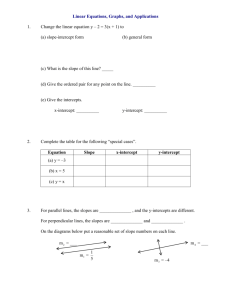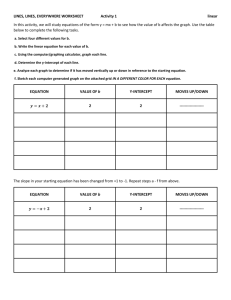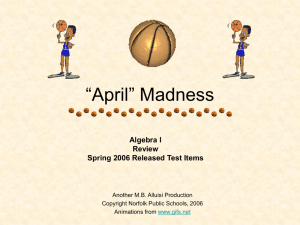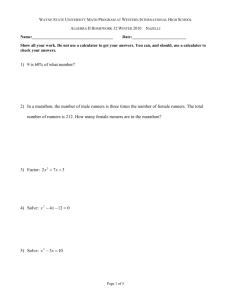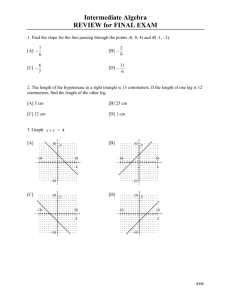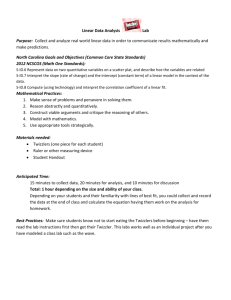S.ID.6.7.8 G.MD.3 Linear Data Analysis_A toast to slope
advertisement
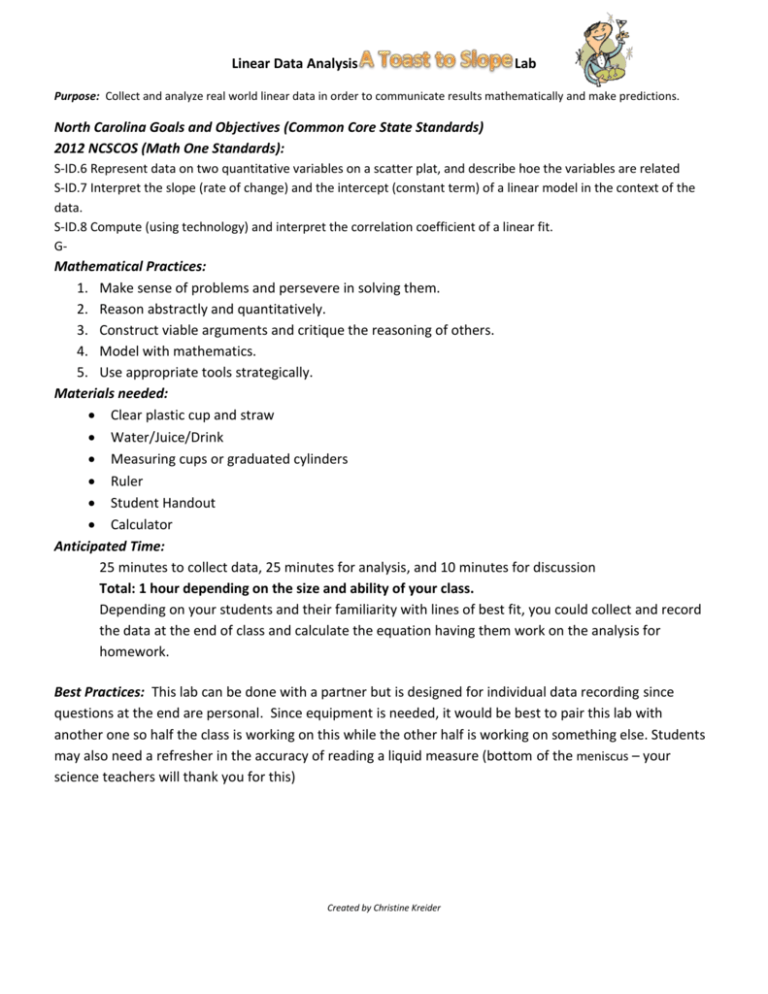
Linear Data Analysis Lab Purpose: Collect and analyze real world linear data in order to communicate results mathematically and make predictions. North Carolina Goals and Objectives (Common Core State Standards) 2012 NCSCOS (Math One Standards): S-ID.6 Represent data on two quantitative variables on a scatter plat, and describe hoe the variables are related S-ID.7 Interpret the slope (rate of change) and the intercept (constant term) of a linear model in the context of the data. S-ID.8 Compute (using technology) and interpret the correlation coefficient of a linear fit. G- Mathematical Practices: 1. Make sense of problems and persevere in solving them. 2. Reason abstractly and quantitatively. 3. Construct viable arguments and critique the reasoning of others. 4. Model with mathematics. 5. Use appropriate tools strategically. Materials needed: Clear plastic cup and straw Water/Juice/Drink Measuring cups or graduated cylinders Ruler Student Handout Calculator Anticipated Time: 25 minutes to collect data, 25 minutes for analysis, and 10 minutes for discussion Total: 1 hour depending on the size and ability of your class. Depending on your students and their familiarity with lines of best fit, you could collect and record the data at the end of class and calculate the equation having them work on the analysis for homework. Best Practices: This lab can be done with a partner but is designed for individual data recording since questions at the end are personal. Since equipment is needed, it would be best to pair this lab with another one so half the class is working on this while the other half is working on something else. Students may also need a refresher in the accuracy of reading a liquid measure (bottom of the meniscus – your science teachers will thank you for this) Created by Christine Kreider Student Name______________________________________________ Date ______________Class Period ______ Collecting and Analyzing Data Directions: 1. Calculate the volume of water in your cup. 2. Take a sip of your water and then calculate the new volume. 3. Continue this process until no drink remains. 4. Record your data in the chart provided a. What is the independent variable(x)? What is the dependent variable (y)? Why? _______________________depends on __________________________ b. Enter the data points into your lists in the calculator and graph the results. Adjusting your window may be necessary. Draw a sketch of the data below with accurate axis labels. Are the points scattered all around the plane or do the points tend to be a certain shape? What shape does your data appear to represent? ____________________ Do any points seem out of place? Why or why not? 4. If your data appears to be linear, determine the equation of the line using your graphing calculator. Round all decimals to 2 places. y = __________________________________________________ 5. What is the slope of your line? _______________ 6. What does the slope mean in the context of this data? During data collection, what factors might have affected the slope? [Type text] (𝒙, 𝒚) 7. What does each point on this line represent in the context of this data? ( (𝑰𝒏𝒅𝒆𝒑𝒆𝒏𝒅𝒆𝒏𝒕 𝑽𝒂𝒓𝒊𝒂𝒃𝒍𝒆, 𝑫𝒆𝒑𝒆𝒏𝒅𝒆𝒏𝒕 𝑽𝒂𝒓𝒊𝒂𝒃𝒍𝒆) 8. What is the y-intercept of your equation? ( 0 , , ) 9. What does the y-intercept mean in context of this data? 10. What is the x-intercept of your equation? ( , 0 ) Show work: Remember: to calculate the x-intercept, let y=0 in the equation 11. What does the x-intercept mean in context of this data? 12. Do you think your equation is a good model of the data? Why or why not? Defend your answer mathematically. 13. Make Predictions using your equation: Based on the data collected, how much water would be consumed if 𝟐. 𝟑 × 𝟏𝟎𝟒 sips were taken? Show work: The Institute of Medicine determined that an adequate intake (AI) for men is roughly 3 liters (about 13 cups) of total beverages a day. The AI for women is 2.2 liters (about 9 cups) of total beverages a day. Based on the data collected, approximately how many sips would it take you to fulfill your adequate daily intake of liquids? Show work: )

